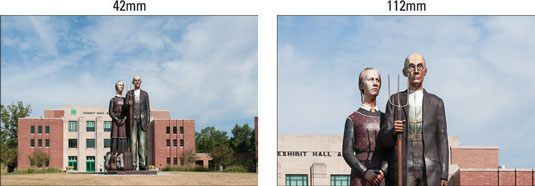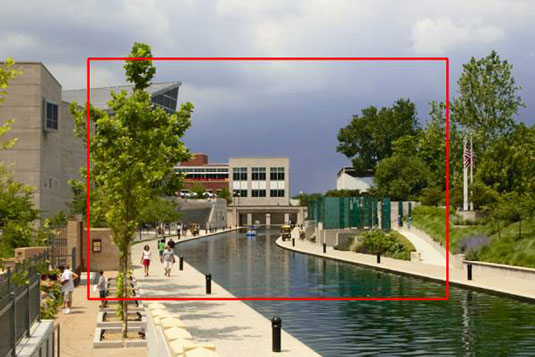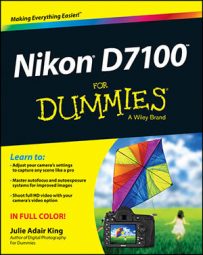One of the biggest differences between a digital point-and-shoot camera and a dSLR (digital single-lens reflex) camera is the lens. To decide which lens is the best partner for your Nikon D7100 camera, start by considering these factors:
Lens compatibility: You can mount a wide range of lenses on your D7100, but some lenses aren’t fully compatible with all camera features. For example, with some lenses, you can’t take advantage of autofocusing and must focus manually.
Your camera manual lists all the lens types that can be mounted on the camera and explains what features are supported with each type. For maximum compatibility, look for these types: Type D or G AF Nikkor, AF-S Nikkor, or AF-I Nikkor. (The latter is an older, expensive professional lens that is no longer sold but might be available on the resale market.)
All the aforementioned lens types (as well as some others) offer CPU (central processing unit) technology, which allows the lens to talk to the camera. This feature is critical to getting maximum performance from the autofocusing system, exposure metering system, and so on. That’s not to say that you can’t use a non-CPU lens; you just lose access to some camera features.
I you’re not using a CPU lens that supports all the camera’s functions, check the camera manual for specifics on what features are unavailable or need to be implemented differently.
Focal length and the crop factor: The focal length of a lens, stated in millimeters, determines the angle of view that the camera can capture and the spatial relationship of objects in the frame. Focal length also affects depth of field, or the distance over which focus appears acceptably sharp.
You can loosely categorize lenses by focal length as follows:
Wide-angle: Lenses with short focal lengths — generally, anything under 35mm — are known as wide-angle lenses. A wide-angle lens has the visual effect of pushing the subject away from you and making it appear smaller. As a result, you can fit more of the scene into the frame without moving back.
Additionally, a wide-angle lens has a large depth of field, which means that both the subject and background objects appear sharp. These characteristics make wide-angle lenses ideal for landscape photography.
Telephoto: Lenses with focal lengths longer than about 70mm are telephoto lenses. These lenses create the illusion of bringing the subject closer to you, increase the subject’s size in the frame, and produce a short depth of field so that the subject is sharply focused but distant objects are blurry. Telephoto lenses are great for capturing wildlife and other subjects that don’t permit up-close shooting.
Normal: A focal length in the neighborhood of 35mm to 70mm is considered “normal” — that is, somewhere between a wide-angle and telephoto. This focal length produces the angle of view and depth of field that are appropriate for the kinds of snapshots that most people take.
The following figure offers an illustration of the difference that focal length makes, showing the same scene captured at 42mm (left image) and 112mm (right image). Of course, the illustration shows just two of countless possibilities, and the question of which focal length best captures a scene depends on your creative goals.

When you put a standard lens on most digital cameras, including your D7100, the available frame area is reduced, as if you took a picture on a camera that uses 35mm film negatives and then cropped it.
This so-called crop factor varies depending on the camera, which is why the photo industry adopted the 35mm-equivalent measuring stick as a standard. With the D7100, the crop factor is 1.5. So the 18–105mm kit lens, for example, captures the approximate area you would get from a 27–158mm lens on a 35mm film camera. (Multiply the crop factor by the lens focal length to get the actual angle of view.)
The red line here indicates the image area that results from the 1.5 crop factor compared with the shot you would get from the same focal length lens mounted on a 35mm film camera.

When shopping for a lens, it's important to remember this crop factor to make sure that you get the focal length designed for the type of pictures you want to take.
Prime versus zoom lenses: A prime lens is a single focal-length lens. With a zoom lens, you get a range of focal lengths in one unit. For example, the kit lens I feature in this book has a focal-length range of 18–105mm.
Aperture range: The aperture is an adjustable diaphragm in a lens. By adjusting the aperture size, you control the amount of light that enters through the lens and strikes the image sensor, thereby controlling exposure.
The aperture setting also affects depth of field: A wide-open aperture produces a short depth of field, so the subject is sharply focused, but distant objects appear blurry; a narrow aperture produces a long depth of field so that both the subject and distant objects appear sharp.
For the purposes of lens shopping, you need to know just a few things.
Every lens has a specific range of aperture settings. Obviously, the larger that range, the more control you have over exposure and depth of field.
The larger the maximum aperture, the “faster” the lens. Aperture settings are stated in f-stops, with a lower number meaning a larger aperture. For example, a setting of f/2 results in a more open aperture than f/4 ansis said to be faster because you can open the aperture wider, thereby allowing more light into the camera and permitting the image to be captured in less time.
This not only benefits you in low-light situations but also when photographing action, which requires a fast shutter speed (short exposure time).
With some zoom lenses, the maximum and minimum aperture change as you zoom the lens. For example, when you zoom to a telephoto focal length, the maximum aperture generally gets smaller — that is, you can't open the aperture as much as you can at a wide-angle setting. You can buy lenses that maintain the same maximum and minimum aperture throughout the whole zoom lens, but you pay more for this feature.

